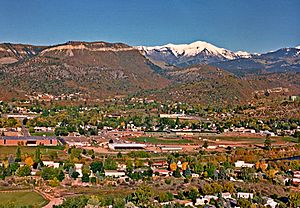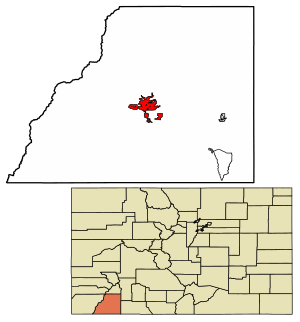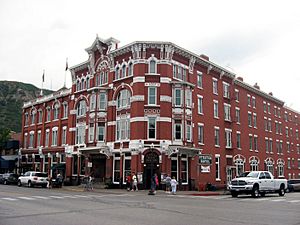Durango, Colorado facts for kids
Quick facts for kids
Durango, Colorado
|
|
|---|---|

Durango as seen from Rim Drive.
|
|
| Motto(s):
"Open Spaces and Familiar Faces"
|
|

Location of the City of Durango in La Plata County, Colorado.
|
|
| Country | |
| State | |
| County | La Plata County seat |
| Founded | 1880 |
| Incorporated | April 27, 1881 |
| Government | |
| • Type | Home rule municipality |
| Area | |
| • Total | 17.103 sq mi (44.296 km2) |
| • Land | 14.708 sq mi (38.093 km2) |
| • Water | 2.395 sq mi (6.203 km2) |
| Population
(2020)
|
|
| • Total | 19,071 |
| • Density | 1,297/sq mi (501/km2) |
| • Metro | 55,638 |
| Demonym(s) | Durangoan |
| Time zone | UTC−07:00 (MST) |
| • Summer (DST) | UTC−06:00 (MDT) |
| ZIP codes |
81301-81303
|
| Area code(s) | 970 |
| FIPS code | 08-22035 |
| GNIS feature ID | 0202983 |
Durango is a home rule municipality that is the county seat and the most populous municipality of La Plata County, Colorado, United States. The city population was 19,071 at the 2020 United States Census. Durango is the home of Fort Lewis College.
Contents
History
The town was organized in September 1880 to serve the San Juan mining district. The Denver and Rio Grande Railroad (D&RG) chose the site on the Animas River for its depot following a brief and most likely perfunctory negotiation with Animas City, two miles to the north. The city was named by ex-Colorado Governor Alexander C. Hunt after Durango, Mexico, based on favorable impression of that city resulting from a scouting trip undertaken on the behalf of William J. Palmer, the head of the D&RG.
Area archaeological sites on the State and National historical registers include:
- Darkmold Site, a Basketmaker culture
- Durango Rock Shelters Archeology Site, a Basketmaker and Pueblo culture
- Spring Creek Archeological District (near Bayfield), another Basketmaker and Pueblo site
- Talus Village, a Basketmaker site
Geography
Durango is located at 37°16′N 107°52′W / 37.267°N 107.867°W at an elevation of 6,512 ft (1,988 m). According to the United States Census Bureau, the city has a total area of 6.8 square miles (18 km2).
Climate
According to the Köppen climate classification system, Durango has a warm-summer, humid continental climate (Dfb). The average annual precipitation is 19.33 in (491 mm). Its hardiness zone is 5b.
| Weather chart for Durango (1971-2000 normals) | |||||||||||||||||||||||||||||||||||||||||||||||
|---|---|---|---|---|---|---|---|---|---|---|---|---|---|---|---|---|---|---|---|---|---|---|---|---|---|---|---|---|---|---|---|---|---|---|---|---|---|---|---|---|---|---|---|---|---|---|---|
| J | F | M | A | M | J | J | A | S | O | N | D | ||||||||||||||||||||||||||||||||||||
|
1.7
40
12
|
1.4
47
17
|
1.7
54
24
|
1.3
63
30
|
1.2
71
37
|
0.6
81
43
|
1.6
85
51
|
2.6
83
50
|
1.9
76
42
|
2.1
66
31
|
1.8
51
21
|
1.4
41
13
|
||||||||||||||||||||||||||||||||||||
| temperatures in °F precipitation totals in inches |
|||||||||||||||||||||||||||||||||||||||||||||||
|
Metric conversion
|
|||||||||||||||||||||||||||||||||||||||||||||||
| Climate data for Durango, Colorado, 1991–2015 normals, extremes 1894–present | |||||||||||||
|---|---|---|---|---|---|---|---|---|---|---|---|---|---|
| Month | Jan | Feb | Mar | Apr | May | Jun | Jul | Aug | Sep | Oct | Nov | Dec | Year |
| Record high °F (°C) | 65 (18) |
71 (22) |
78 (26) |
84 (29) |
98 (37) |
98 (37) |
102 (39) |
99 (37) |
96 (36) |
87 (31) |
74 (23) |
64 (18) |
102 (39) |
| Average high °F (°C) | 40.9 (4.9) |
45.8 (7.7) |
54.9 (12.7) |
62.7 (17.1) |
72.2 (22.3) |
81.5 (27.5) |
86.0 (30.0) |
83.6 (28.7) |
76.4 (24.7) |
65.0 (18.3) |
50.6 (10.3) |
40.9 (4.9) |
63.4 (17.4) |
| Average low °F (°C) | 14.5 (−9.7) |
19.4 (−7.0) |
25.8 (−3.4) |
31.2 (−0.4) |
39.3 (4.1) |
47.1 (8.4) |
54.5 (12.5) |
53.1 (11.7) |
45.4 (7.4) |
34.6 (1.4) |
23.2 (−4.9) |
15.3 (−9.3) |
33.6 (0.9) |
| Record low °F (°C) | −30 (−34) |
−27 (−33) |
−9 (−23) |
0 (−18) |
15 (−9) |
16 (−9) |
33 (1) |
31 (−1) |
20 (−7) |
5 (−15) |
−14 (−26) |
−21 (−29) |
−30 (−34) |
| Average precipitation inches (mm) | 2.30 (58) |
1.79 (45) |
1.42 (36) |
1.53 (39) |
1.16 (29) |
0.57 (14) |
1.77 (45) |
2.81 (71) |
2.19 (56) |
2.02 (51) |
1.64 (42) |
1.75 (44) |
20.95 (530) |
| Average snowfall inches (cm) | 19.9 (51) |
14.9 (38) |
6.0 (15) |
3.7 (9.4) |
0.2 (0.51) |
0.0 (0.0) |
0.0 (0.0) |
0.0 (0.0) |
0.0 (0.0) |
1.1 (2.8) |
5.7 (14) |
13.2 (34) |
64.7 (164.71) |
Demographics
| Historical population | |||
|---|---|---|---|
| Census | Pop. | %± | |
| 1890 | 2,726 | — | |
| 1900 | 3,317 | 21.7% | |
| 1910 | 4,686 | 41.3% | |
| 1920 | 4,116 | −12.2% | |
| 1930 | 5,400 | 31.2% | |
| 1940 | 5,887 | 9.0% | |
| 1950 | 7,459 | 26.7% | |
| 1960 | 10,530 | 41.2% | |
| 1970 | 10,333 | −1.9% | |
| 1980 | 11,649 | 12.7% | |
| 1990 | 12,430 | 6.7% | |
| 2000 | 13,922 | 12.0% | |
| 2010 | 16,887 | 21.3% | |
| 2020 | 19,071 | 12.9% | |
| U.S. Decennial Census | |||
As of the 2000 census, there were 13,922 people, 5,492 households, and 2,603 families residing in the city. The population density was 2,052.4 people per square mile (792.8/km2). There were 5,819 housing units at an average density of 857.8 per square mile (331.4/km2). The racial makeup of the city was 86.8% White, 0.5% African American, 5.5% Native American, 0.7% Asian, 0.1% Pacific Islander, 4.1% from other races, and 2.2% from two or more races. Hispanic or Latino of any race were 10.3% of the population.
There were 5,492 households, out of which 22.4% had children under the age of 18 living with them, 34.2% were married couples living together, 9.4% had a single female householder, and 52.6% were non-families. 31.8% of all households were made up of individuals, and 9.0% had someone living alone who was 65 years of age or older. The average household size was 2.23 and the average family size was 2.83.
In the city, 16.6% of residents were under the age of 18, 26.1% from 18 to 24, 27.2% from 25 to 44, 19.4% from 45 to 64, and 10.7% who were 65 years of age or older. The median age was 29 years. For every 100 females, there were 104.1 males. For every 100 females age 18 and over, there were 103.8 males.
The median income for a household in the city was $34,892, and the median income for a family was $50,814. Males had a median income of $31,812 versus $25,022 for females. The per capita income for the city was $19,352. 17.2% of the population and 7.3% of families were living below the poverty line. 11.2% of those younger than 18 and 8.9% of those 65 and older were living below the poverty line.
Arts and culture
Attractions
Animas River Valley
Durango is nestled in the Animas River Valley surrounded by the San Juan Mountains. The Animas River—El Río de las Animas (River of Souls)—runs through downtown and boasts gold medal fly fishing waters, and is popular for whitewater rafting, kayaking and canoeing. Durango is also popular for outdoor activities like hiking, mountain biking, road biking, backpacking, slacklining, rock climbing, hunting, off-roading, year-round fishing, and golfing.
Purgatory Resort
Durango is near five major ski areas, including Purgatory, formerly known as Durango Mountain Resort, located 26 miles north of downtown. The city is located thirty-five miles east of Mesa Verde National Park, a UNESCO World Heritage Site best known for its Ancestral Puebloans cliff dwellings.
Durango Ragtime & Early Jazz Festival
The annual Durango Ragtime & Early Jazz Festival features noted musicians from around the country. It is held in the Strater Hotel, a historic Victorian hotel in Durango.
Durango & Silverton Narrow Gauge Railroad
Durango is most known for the Durango & Silverton Narrow Gauge Railroad, a heritage railway, which travels from Durango to the historic mining town of Silverton, Colorado on steam-powered trains with rolling stock dating back to the 1920s and before.
Mountain Bike World Championships
Durango hosted the first-ever Mountain Bike World Championships in 1990.
Snowdown Festival
Durango is home to the Snowdown Festival, an event that has a new, original theme each year, and includes a single firework to start off the ever popular light parade. The parade is the centerpiece and usually occurs the last Friday of January or the first Friday of February. Many local businesses hold competitions throughout the week, including a beard growing contest, joke off, hot wing eating contest, beer plunge, outhouse stuffing and many others.
Main Avenue
Main Avenue cuts through Downtown Durango, home to clothing boutiques, restaurants, newsstands, tourist and gift shops, a mall, bars, lounges and other businesses. Many buildings downtown are several stories high and include apartments in the upper levels. Durango's two oldest hotels, The General Palmer and The Strater Hotel, are both at the South end of Main Avenue, one and two blocks away from the train station, respectively. It is also home to many restaurants. Durango has more restaurants per capita than Denver. Many serve specialty foods including Mexican, Italian, French, Thai and Japanese and others serve American favorites. Main Avenue is walked by thousands of tourists each week, making it the most popular shopping and relaxing tourist destination in Durango.
Sister cities
- Much of the 1953 western movie The Naked Spur starring James Stewart was shot in Durango.
- Several parts of the 1955 western film Run for Cover starring James Cagney, were filmed just north of Durango in and around the upper Hermosa Valley area.
- In 1965, Rosemary DeCamp played Durango newspaper editor Caroline Romney in the episode, "Mrs. Romney and the Outlaws" of the syndicated television series, Death Valley Days. In the story line, Romney sounds the alarm for citizens to fight the Kimball/Sykes gang. Willard Sage played Marshal Christy.
- Parts of the 1969 film Butch Cassidy and the Sundance Kid were filmed north of town along the Animas River.
- Part of the 1991 film City Slickers was shot in Durango.
- The 1999 movie Durango Kids describes a time tunnel in the old mines outside of Durango.
- Parts of the 1993 film "Cliffhanger" were shot in Durango.
Infrastructure
Public Transportation
Durango is served by U.S. Highway 160 (the Old Spanish Trail), running east–west, and U.S. Highway 550, running north–south. Part of U.S. 550 offers high-speed access (primarily a 4-lane, divided highway) to Albuquerque, New Mexico. North of Durango, 550 is nicknamed the Million Dollar Highway, and is part of the scenic San Juan Skyway.
Durango is served by Durango–La Plata County Airport (IATA code: DRO), a major regional airport for southwestern Colorado, located near Ignacio, Colorado. The airport is serviced year-round by regional carriers Mesa Airlines (American Eagle), SkyWest Airlines (American Eagle and United Express), Republic Airways (United Express), and Envoy Air (American Eagle).
As of 2014, regional connecting hubs to DRO include Dallas/Fort Worth International Airport (DFW), Phoenix Sky Harbor International Airport (PHX), and Denver International Airport (DEN).
Durango Transit provides several loop bus routes in the community, including Fort Lewis College. Normal hours of operation are weekdays from 6:30 am to 6:30 pm. Ignacio Road Runner provides bus service to the nearby towns of Ignacio, Colorado and Bayfield, Colorado, with four trips daily on weekdays and one on Saturdays. Both services share the Durango Transit Center as a hub.
Greyhound Lines formerly served Durango, but after budget cuts, the service was discontinued. Since 2014, Road Runner Transit (a service of Southern Ute Community Action Programs) has restored daily bus service between Grand Junction and Durango. Since 2018, Road Runner's service has been incorporated into the larger mantle of the state-run program Bustang.
Notable people
- Paco Ahlgren, writer
- Ross Anderson, World Cup/professional speed skier, All-American record holder
- Steve Carlton, Baseball Hall of Fame pitcher
- James Garesche Ord, United States Army Major General, born at Fort Lewis near Durango
- Missy Giove, cyclist inducted into the Mountain Bike Hall of Fame
- Howard Grotts, cyclist
- Greg Herbold, cyclist inducted into the Mountain Bike Hall of Fame
- Sepp Kuss, cyclist, Vuelta a España and Tour de France stage winner
- Matt Miller, NFL offensive tackle for the Cleveland Browns
- Ned Overend, cyclist inducted into the Mountain Bike Hall of Fame and the United States Bicycling Hall of Fame
- Stuart Roosa, NASA astronaut and former USFS Smoke Jumper, carried Redwood seeds on the Apollo 14 Moon mission which are now planted in several US parks
- Quinn Simmons, cyclist
- Ed Stasium, record producer
- Tom Tully, actor, Oscar nominee for The Caine Mutiny
- Shan Wells, sculptor and illustrator
- Todd Wells, cyclist
- Eli Tomac, professional motocross racer
- Gary Cook, two-time Flat Pick Champion (1989, 1996)
See also
 In Spanish: Durango (Colorado) para niños
In Spanish: Durango (Colorado) para niños



